(word完整版)人教版初中英语八大时态详解
(完整版)初中英语语法八大时态总结(完整版)
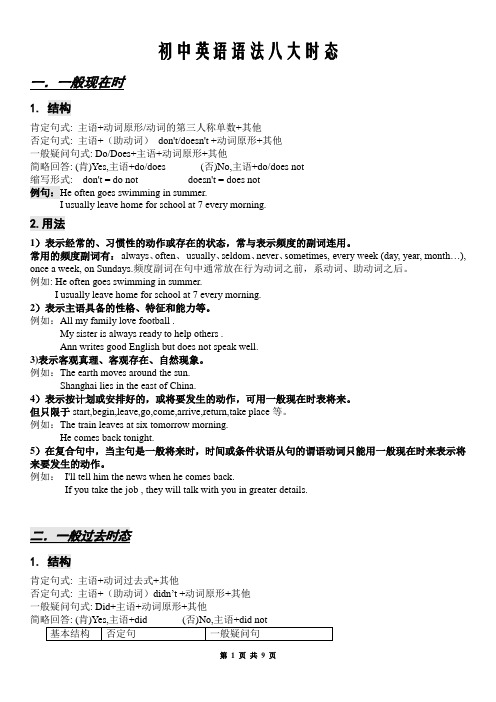
初中英语语法八大时态一.一般现在时1.结构肯定句式: 主语+动词原形/动词的第三人称单数+其他否定句式: 主语+(助动词)don't/doesn't +动词原形+其他一般疑问句式: Do/Does+主语+动词原形+其他简略回答: (肯)Yes,主语+do/does (否)No,主语+do/does not缩写形式: don't = do not doesn't = does not例句:He often goes swimming in summer.I usually leave home for school at 7 every morning.2.用法1)表示经常的、习惯性的动作或存在的状态,常与表示频度的副词连用。
常用的频度副词有:always、often、usually、seldom、never、sometimes, every week (day, year, month…), once a week, on Sundays.频度副词在句中通常放在行为动词之前,系动词、助动词之后。
例如: He often goes swimming in summer.I usually leave home for school at 7 every morning.2)表示主语具备的性格、特征和能力等。
例如:All my family love football .My sister is always ready to help others .Ann writes good English but does not speak well.3)表示客观真理、客观存在、自然现象。
例如:The earth moves around the sun.Shanghai lies in the east of China.4)表示按计划或安排好的,或将要发生的动作,可用一般现在时表将来。
(完整版)初中英语八大时态总结

初中英语八大时态总结一、一般现在时具体情况(主要用于下面几情况)1) 描述当前时间内经常出现、反复发生的动作或存在的状态。
在这种情景中,句子常带有表示频率的时间状语:always , everyday , often , once a week (month ,year , etc。
), sometimes , seldom , usually等等,以表示句中的动作或状态是习惯性的、经常性的。
例如:They raise ducks as a sideline 。
他们以养鸭为副业.It seldom rains here 。
这儿很少下雨.2)仅为了描述状态、性质、特征、能力等等。
这里的目的是为了"描述现阶段的动作或状态”,其重点”不是强调动作发生的时间、或进行的状态”。
例如:He can speak five foreign languages .他能说五种外语。
That is a beautiful city 。
那是座美丽的城市。
3)陈述客观事实、客观真理。
顾名思义,客观的情况是"没有时间概念"的;也"不会在意动作进行的状态”。
例如:The sun rises in the east .日出东方。
4)根据英文语法规定,当主句的谓语动词是一般将来时,那么时间或条件状语从句的谓语动词只能用一般现在时来表示将来要发生的动作.例如:I’ll tell him the news when he comes back. 他回来时,我将告诉他这个消息。
*【用于一般现在时的副词,除了上面提到的一些表示频率的以外,常见的还有:now, today , nowadays 等等】二、一般过去时具体情况(主要用于下面几情况)1.主要是用来描述在过去某个时候发生的动作或存在的状态。
它也可以用来表示在过去某段时间里经常发生的习惯性动作。
例:I was very thin in my childhood。
(完整版)英语常用的八种时态
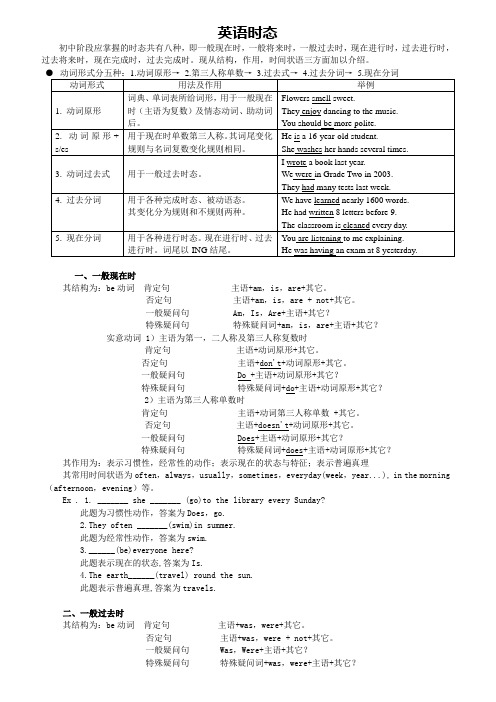
英语时态初中阶段应掌握的时态共有八种,即一般现在时,一般将来时,一般过去时,现在进行时,过去进行时,过去将来时,现在完成时,过去完成时。
现从结构,作用,时间状语三方面加以介绍。
一、一般现在时其结构为:be动词肯定句主语+am,is,are+其它。
否定句主语+am,is,are + not+其它。
一般疑问句 Am,Is,Are+主语+其它?特殊疑问句特殊疑问词+am,is,are+主语+其它?实意动词1)主语为第一,二人称及第三人称复数时肯定句主语+动词原形+其它。
否定句主语+don't+动词原形+其它。
一般疑问句 Do +主语+动词原形+其它?特殊疑问句特殊疑问词+do+主语+动词原形+其它?2)主语为第三人称单数时肯定句主语+动词第三人称单数 +其它。
否定句主语+doesn't+动词原形+其它。
一般疑问句 Does+主语+动词原形+其它?特殊疑问句特殊疑问词+does+主语+动词原形+其它?其作用为:表示习惯性,经常性的动作;表示现在的状态与特征;表示普遍真理其常用时间状语为often,always,usually,sometimes,everyday(week,year...), in the morning (afternoon,evening)等。
Ex . 1. _______ she _______ (go)to the library every Sunday?此题为习惯性动作,答案为Does,go.2.They often _______(swim)in summer.此题为经常性动作,答案为swim.3.______(be)everyone here?此题表示现在的状态,答案为Is.4.The earth______(travel) round the sun.此题表示普遍真理,答案为travels.二、一般过去时其结构为:be动词肯定句主语+was,were+其它。
(完整)初中英语八种时态详解
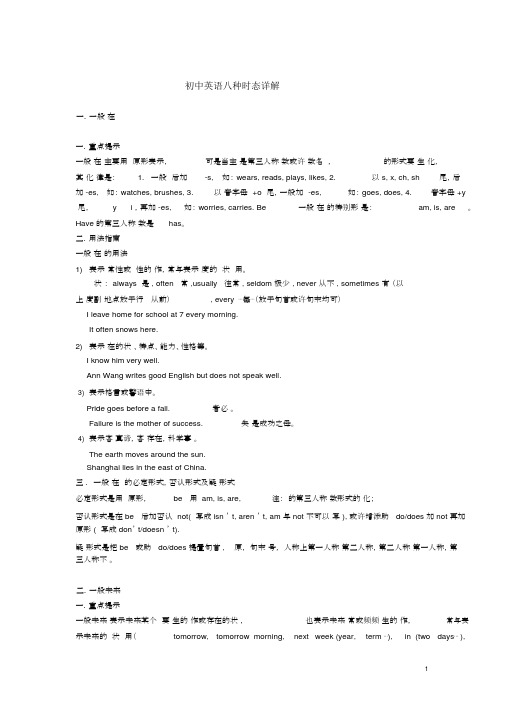
初中英语八种时态详解一.一般在一.重点提示一般在主要用原形表示,可是当主是第三人称数或许数名,的形式要生化,其化律是: 1.一般后加-s,如:wears, reads, plays, likes, 2.以s, x, ch, sh尾,后加 -es,如:watches, brushes, 3.以音字母+o尾,一般加-es,如:goes, does, 4.音字母+y 尾,y i ,再加 -es,如:worries, carries. Be一般在的特别形是:am, is, are。
Have 的第三人称数是has。
二.用法指南一般在的用法1)表示常性或性的作,常与表示度的状用。
状: always 是 , often 常 ,usually 往常 , seldom 极少 , never 从不 , sometimes 有(以上度副地点放于行从前), every ⋯每⋯(放于句首或许句末均可)I leave home for school at 7 every morning.It often snows here.2)表示在的状、特点、能力、性格等。
I know him very well.Ann Wang writes good English but does not speak well.3)表示格言或警语中。
Pride goes before a fall.者必。
Failure is the mother of success.失是成功之母。
4)表示客真谛,客存在,科学事。
The earth moves around the sun.Shanghai lies in the east of China.三 .一般在的必定形式,否认形式及疑形式必定形式是用原形,be 用 am, is, are,注:的第三人称数形式的化;否认形式是在 be 后加否认 not( 写成 isn ’ t, aren ’ t, am 与 not 不可以写 ), 或许增添助 do/does 加 not 再加原形 ( 写成 don’ t/doesn ’ t).疑形式是把 be 或助 do/does 提置句首 , 原,句末号,人称上第一人称第二人称,第二人称第一人称,第三人称不。
八大时态讲解

一般将来时的注意点:
be going to 与 will /shall区别: be going to 指当前的、已计划过或思考过的意图 和打算;
如:I am going to listen to music. (我打算听音乐 )
will /shall 表示未事先思考或为计划过的意图 如:It will be Christmas soon .(很快就圣诞节了 )
3.一般将来时态(The Simple Future Tense)
概念:表示将来某个时间要发生的动作或存
在的状态
谓语动词形式
:12..
will/shall+do am/is/are going
to+do
3. am/is/are + doing
常用时间状语 :
tomorrow, in three days,this…,
• 将来完成时: We will have had our exam by September 20.
• 过去将来完成时: He told them he would have finished by 9 o’clock.
英语的动词时态(完成进行)
• 现在完成进行时: Obviously she’s been crying. It has been snowing all night. The ground is covered with thick snow.
• 一般将来时: We will have a test next month. He is going to buy her some flowers.
• 一般过去将来时: He was sixty-eight. In two years he would be seventy. I knew you would agree.
人教版初中英语八大时态详解

人教版xx八大时态详解英语的时态(tense)是一种动词形式,不同的时态用以表示不同的时间与方式。
下面就英语中常见的八种基本时态进行阐述,其它的时态都是在这八种时态的基础上结合而成的。
一、一般现在时:1.概念:经常、反复发生的动作或行为及现在的某种状况。
2.时间状语:always, usually, often, sometimes, every week (day, year, month...),once a week, on Sundays,3.基本结构:动词原形(如主语为第三人称单数,动词上要加(e)S)4.否定形式:am/is/are+not;此时态的谓语动词若为行为动词,则在其前加don't,如主语为第三人称单数,则用doesn't,通常还原行为动词。
5.一般疑问句:把be动词放于句首;用助动词do提问,如主语为第三人称单数,则用does,同时,还原行为动词。
6.例句:It seldom snows here.He is always ready to help others.Action speaks louder than words.二、一般过去时:1.概念:过去某个时间里发生的动作或状态;过去习惯性、经常性的动作、行为。
2.时间状语:ago, yesterday, the day before yesterday, last week(year, night,month…), in 1989, just now, at the age of 5, one day, long long ago, once upon atime, etc.3.基本结构:be动词;行为动词4.否定形式:was/were+not;在行为动词前加didn't,同时还原行为动词。
5.一般疑问句:was或were放于句首;用助动词do的过去式did提问,同时还原行为动词。
6.例句:She often came to help us in those days.I didn't know you were so busy.三、现在进行时:1.概念:表示现阶段或说话时正在进行的动作及行为。
初中英语语法八大时态总结完整版
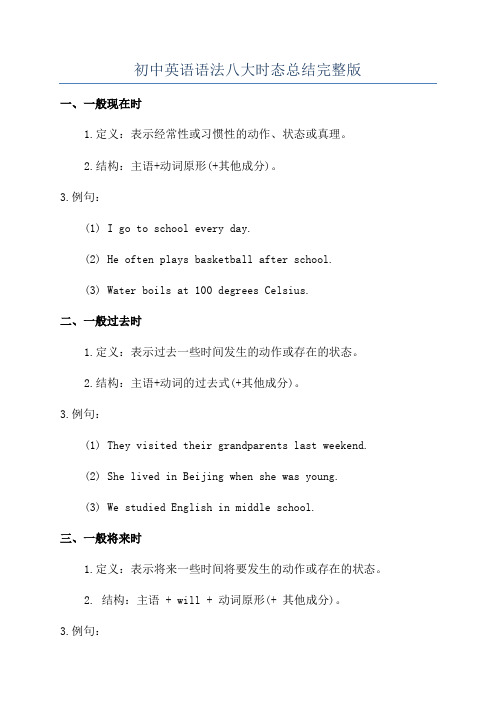
初中英语语法八大时态总结完整版一、一般现在时1.定义:表示经常性或习惯性的动作、状态或真理。
2.结构:主语+动词原形(+其他成分)。
3.例句:(1) I go to school every day.(2) He often plays basketball after school.(3) Water boils at 100 degrees Celsius.二、一般过去时1.定义:表示过去一些时间发生的动作或存在的状态。
2.结构:主语+动词的过去式(+其他成分)。
3.例句:(1) They visited their grandparents last weekend.(2) She lived in Beijing when she was young.(3) We studied English in middle school.三、一般将来时1.定义:表示将来一些时间将要发生的动作或存在的状态。
2. 结构:主语 + will + 动词原形(+ 其他成分)。
3.例句:(1) I will go to the park tomorrow.(3) We will have a party next week.四、现在进行时1.定义:表示现在正在进行的动作。
2. 结构:主语 + am/is/are + 动词-ing(+ 其他成分)。
3.例句:(1) She is reading a book right now.(2) They are playing soccer in the park.(3) We are having dinner at the moment.五、过去进行时1.定义:表示过去一些时间正在进行的动作。
2. 结构:主语 + was/were + 动词-ing(+ 其他成分)。
3.例句:(1) He was watching TV at 8 o'clock last night.(2) They were traveling in Europe during summer vacation.(3) We were studying when the phone rang.六、将来进行时1.定义:表示将来一些时间正在进行的动作。
初中英语语法八大时态总结完整版初中英语时态总结
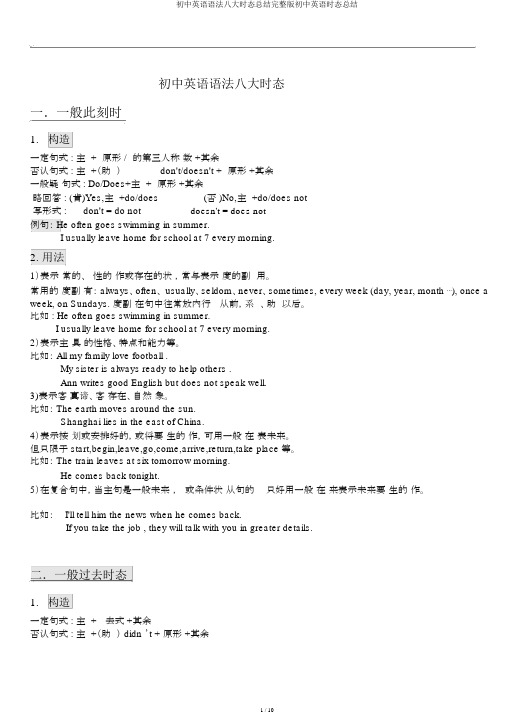
初中英语语法八大时态总结完整版初中英语时态总结初中英语语法八大时态一.一般此刻时1.构造一定句式 : 主 +原形 /的第三人称数 +其余否认句式 : 主 +(助)don't/doesn't +原形 +其余一般疑句式 : Do/Does+主 +原形 +其余略回答 : (肯)Yes,主 +do/does(否 )No,主 +do/does not写形式 : don't = do not doesn't = does not例句: He often goes swimming in summer.I usually leave home for school at 7 every morning.2.用法1)表示常的、性的作或存在的状,常与表示度的副用。
常用的度副有: always、often、 usually、seldom、never、sometimes, every week (day, year, month ⋯), once a week, on Sundays. 度副在句中往常放内行从前,系、助以后。
比如 : He often goes swimming in summer.I usually leave home for school at 7 every morning.2)表示主具的性格、特点和能力等。
比如: All my family love football .My sister is always ready to help others .Ann writes good English but does not speak well.3)表示客真谛、客存在、自然象。
比如: The earth moves around the sun.Shanghai lies in the east of China.4)表示按划或安排好的,或将要生的作,可用一般在表未来。
- 1、下载文档前请自行甄别文档内容的完整性,平台不提供额外的编辑、内容补充、找答案等附加服务。
- 2、"仅部分预览"的文档,不可在线预览部分如存在完整性等问题,可反馈申请退款(可完整预览的文档不适用该条件!)。
- 3、如文档侵犯您的权益,请联系客服反馈,我们会尽快为您处理(人工客服工作时间:9:00-18:30)。
人教版初中英语八大时态详解
英语的时态(tense)是一种动词形式,不同的时态用以表示不同的时间与方式。
下面就英语中常见的八种基本时态进行阐述,其它的时态都是在这八种时态的基础上结合而成的。
一、一般现在时:
1.概念:经常、反复发生的动作或行为及现在的某种状况。
2.时间状语:always, usually, often, sometimes, every week (day, year, month...), once a week, on Sundays,
3.基本结构:动词原形(如主语为第三人称单数,动词上要加(e)S)
4.否定形式:am/is/are+not;此时态的谓语动词若为行为动词,则在其前加don't,如主语为第三人称单数,则用doesn't,通常还原行为动词。
5.一般疑问句:把be动词放于句首;用助动词do提问,如主语为第三人称单数,则用does,同时,还原行为动词。
6.例句:It seldom snows here.
He is always ready to help others.
Action speaks louder than words.
二、一般过去时:
1.概念:过去某个时间里发生的动作或状态;过去习惯性、经常性的动作、行为。
2.时间状语:ago, yesterday, the day before yesterday, last week(year, night, month…), in 1989, just now, at the age of 5, one day, long long ago, once upon a time, etc.
3.基本结构:be动词;行为动词
4.否定形式:was/were+not;在行为动词前加didn't,同时还原行为动词。
5.一般疑问句:was或were放于句首;用助动词do的过去式did 提问,同时还原行为动词。
6.例句:She often came to help us in those days.
I didn't know you were so busy.
三、现在进行时:
1.概念:表示现阶段或说话时正在进行的动作及行为。
2.时间状语:now, at this time, these days, etc.
3.基本结构:am/is/are+doing
4.否定形式:am/is/are+not+doing.
5.一般疑问句:把be动词放于句首。
6.例句:How are you feeling today?
He is doing well in his lessons.
四、过去进行时:
1.概念:表示过去某段时间或某一时刻正在发生或进行的行为或动作。
2.时间状语:at this time yesterday, at that time或以when引导的谓语动词是一般过去时的时间状语等。
3.基本结构:was/were+doing
4.否定形式:was/were + not + doing.
5.一般疑问句:把was或were放于句首。
6.例句:At that time she was working in a PLA unit.
When he came in, I was reading a newspaper.
五、现在完成时:
1.概念:过去发生或已经完成的动作对现在造成的影响或结果,或从过去已经开始,持续到现在的动作或状态。
2.时间状语:recently, l ately, since…for…,in the past few years, etc.
3.基本结构:have/has + done
4.否定形式:have/has + not +done.
5.一般疑问句:have或has提前
6.例句:I've written an article.
It has been raining these days.
六、过去完成时:
1.概念:以过去某个时间为标准,在此以前发生的动作或行为,或在过去某动作之前完成的行为,即“过去的过去”。
2.时间状语:before, by the end of last year(term, month…),etc.
3.基本结构:had + done.
4.否定形式:had + not + done.
5.一般疑问句:had放于句首。
6.例句:As soon as we got to the station, the train had left.
By the end of last month. We had reviewed four books
七、一般将来时:
1.概念:表示将要发生的动作或存在的状态及打算、计划或准备做某事。
2.时间状语:tomorrow, next day(week, month, year…),soon, in a few minutes, by…,the day after tomorrow, etc.
3.基本结构:am/is/are/going to + do;will/shall + do.
4.否定形式:was/were + not; 在行为动词前加won't,同时还原行为动词。
5.一般疑问句:be放于句首;will/shall提到句首。
6.例句:They are going to have a competition with us in studies.
It is going to rain.
八、过去将来时:
1.概念:立足于过去某一时刻,从过去看将来,常用于宾语从句中。
2.时间状语:the next day(morning, year…),the following month(week…),etc.
3.基本结构:was/were/going to do;would/should + do.
4.否定形式:was/were/not + going to + do;would/should + not + do.
5.一般疑问句:was或were放于句首;would/should 提到句首。
6.例句:He said he would go to Beijing the next day.
I asked who was going there .
1.一般现在时: 主语+do/does(现在分词)
e.g We clean the room every day.
2.一般过去时: 主语+did
e.g We cleaned the room just now.
3.现在进行时: 主语+am/is/are doing
e.g We are cleaning the room now.
4.过去进行时: was/were doing
e.g We were cheaning the room at 5:00 yesterday afternoon.
5.现在完成时: have/has done
e.g.We have cleaned the room already.
6.过去完成时: had done
e.g We had cleaned the room before he arrived.
7.一般将来时: will do/
e.g We will clean the room tomorrow.
8.过去将来时: was/were to /would do
e.g He said he would clean the room next.。
